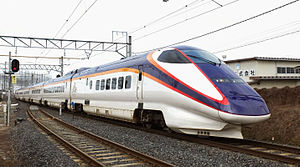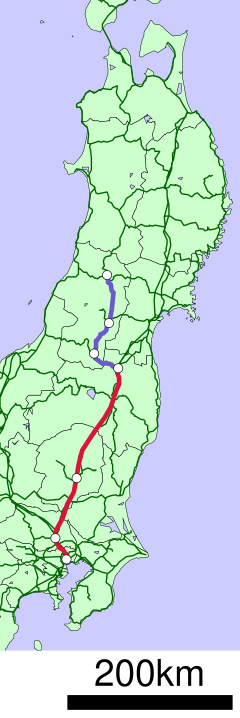
A | B | C | D | E | F | G | H | CH | I | J | K | L | M | N | O | P | Q | R | S | T | U | V | W | X | Y | Z | 0 | 1 | 2 | 3 | 4 | 5 | 6 | 7 | 8 | 9
| Yamagata Shinkansen | |||
|---|---|---|---|
 E3-1000 series train set L54 on the Yamagata Shinkansen between Kita and Yamagata in March 2015 | |||
| Overview | |||
| Native name | 山形新幹線 | ||
| Status | Operational | ||
| Owner | |||
| Locale | Fukushima and Yamagata Prefectures | ||
| Termini | |||
| Stations | 11 | ||
| Color on map | Orange (#f36221) | ||
| Service | |||
| Type | Mini-shinkansen | ||
| Operator(s) | JR East | ||
| Depot(s) | Yamagata | ||
| Rolling stock | |||
| History | |||
| Opened | July 1, 1992 (Tokyo - Yamagata) December 4, 1999 (Yamagata - Shinjō) | ||
| Technical | |||
| Line length | 148.6 km (92.3 mi) | ||
| Number of tracks | Double-track ( Single-track in some sections) | ||
| Track gauge | 1,435 mm (4 ft 8+1⁄2 in) standard gauge | ||
| Electrification | Overhead line:
| ||
| Operating speed |
| ||
| Maximum incline | 3.75% | ||
| |||
The Yamagata Shinkansen (山形新幹線) is a Mini-shinkansen route in Japan, operated by East Japan Railway Company (JR East). It provides service between Tokyo and Shinjō in Yamagata Prefecture over the tracks of the Tohoku Shinkansen and the Ōu Main Line.
The term Yamagata Shinkansen refers to the segment that connects Fukushima and Shinjō. Because the shinkansen trains share tracks with regular Zairasen (conventional lines) trains, it is often referred to as a "mini-shinkansen".
Operations

Trains consist of 7-car E3 series trainsets operating as Tsubasa services. Between Tokyo and Fukushima, some trains run coupled to Yamabiko trains on the Tōhoku Shinkansen. Between Fukushima and Shinjō, the trains run on their own at a maximum speed of 130 km/h (80 mph) and share the line with regular Ōu Main Line trains.[1]
As of July 2012, about 62 million passengers had ridden the line since it opened in July 1992.[2] The fastest trains connect Tokyo and Yamagata stations in two hours and 29 minutes.[2]
Construction of a new approach line at Fukushima Station
In April 2021, JR East started construction of a new approach line at Fukushima station. Currently, the Yamagata Shinkansen can only enter and exit the Tohoku Shinkansen through platform 14 at Fukushima Station. This current layout requires the Yamagata Shinkansen to cross the north bound tracks to reach the Tokyo bound tracks. This new approach line will pass under the Tohoku Shinkansen, which will allow Yamagata Shinkansen to enter the Tohoku Shinkansen on platform 11 removing the crossing and reducing the gravitude of transport disruption. Construction is expected to finish by the end of fiscal year 2026.[3]
Proposed Ou base tunnel
Construction of a base tunnel on the Yamagata Shinkansen is proposed, with JR East having undertaken a survey of a planned route from Niwasaka to Sekine, just south of Yonezawa station.[4] 23.1 km (14.4 mi) of the proposed 24.9 km (15.5 mi) line would be in tunnel, mostly to the north of the existing 88 km (55 mi) Fukushima – Yamagata section. To be built on an improved alignment, the tunnel would lower journey times between Fukushima and Yamagata by ~10 min due to a proposed line speed of up to 200 km/h (124 mph).[5]
The tunnel would avoid the Itaya Toge pass through the Ou mountains west of Fukushima. Gradients range from 3.0% to 3.8% and the line reaches an altitude of 548 m (1,798 ft). The curvature and steep grades limit train speeds to 55 km/h (34 mph) or less, and the line is vulnerable to heavy rain and snowfall as well as high winds.[4] Between 2011 and 2017 a total of 410 Yamagata mini-Shinkansen services were either suspended or delayed, and 40% of these incidents occurred on the line over the Itaya Toge pass.[4]
If the ¥150 billion base tunnel is authorised, detailed design would take five years and construction another 15 years.[6] The cost could increase by ¥12 billion if the tunnel were to be built with a cross-section large enough to permit the line to be upgraded to the full Shinkansen Loading gauge.[4]
Station list
Route map | |||||||||||||||||||||||||||||||||||||||||||||||||||||||||||||||||||||||||||||||||||||||||||||||||||||||||||||||||||||||||||||||||||||||||||||||||||||||||||||||||||||||||||||||||||||||||||||||||||||||||||||||||||||||||||||||||||||||||||||||||||||||||||||||||||||||||||||||||||||||||||||||||||||||||||||||||||||||||||||||||||||||||||||||||||||||||||||||||||||||||||||||||||||||||||||||||||||||||||||||||||||||||||||||||||||||
|---|---|---|---|---|---|---|---|---|---|---|---|---|---|---|---|---|---|---|---|---|---|---|---|---|---|---|---|---|---|---|---|---|---|---|---|---|---|---|---|---|---|---|---|---|---|---|---|---|---|---|---|---|---|---|---|---|---|---|---|---|---|---|---|---|---|---|---|---|---|---|---|---|---|---|---|---|---|---|---|---|---|---|---|---|---|---|---|---|---|---|---|---|---|---|---|---|---|---|---|---|---|---|---|---|---|---|---|---|---|---|---|---|---|---|---|---|---|---|---|---|---|---|---|---|---|---|---|---|---|---|---|---|---|---|---|---|---|---|---|---|---|---|---|---|---|---|---|---|---|---|---|---|---|---|---|---|---|---|---|---|---|---|---|---|---|---|---|---|---|---|---|---|---|---|---|---|---|---|---|---|---|---|---|---|---|---|---|---|---|---|---|---|---|---|---|---|---|---|---|---|---|---|---|---|---|---|---|---|---|---|---|---|---|---|---|---|---|---|---|---|---|---|---|---|---|---|---|---|---|---|---|---|---|---|---|---|---|---|---|---|---|---|---|---|---|---|---|---|---|---|---|---|---|---|---|---|---|---|---|---|---|---|---|---|---|---|---|---|---|---|---|---|---|---|---|---|---|---|---|---|---|---|---|---|---|---|---|---|---|---|---|---|---|---|---|---|---|---|---|---|---|---|---|---|---|---|---|---|---|---|---|---|---|---|---|---|---|---|---|---|---|---|---|---|---|---|---|---|---|---|---|---|---|---|---|---|---|---|---|---|---|---|---|---|---|---|---|---|---|---|---|---|---|---|---|---|---|---|---|---|---|---|---|---|---|---|---|---|---|---|---|---|---|---|---|---|---|---|---|---|---|---|---|---|---|---|---|---|---|---|---|---|---|---|---|---|---|---|---|---|---|---|---|---|---|---|---|---|---|---|---|---|---|---|---|---|---|---|---|---|---|---|---|
| |||||||||||||||||||||||||||||||||||||||||||||||||||||||||||||||||||||||||||||||||||||||||||||||||||||||||||||||||||||||||||||||||||||||||||||||||||||||||||||||||||||||||||||||||||||||||||||||||||||||||||||||||||||||||||||||||||||||||||||||||||||||||||||||||||||||||||||||||||||||||||||||||||||||||||||||||||||||||||||||||||||||||||||||||||||||||||||||||||||||||||||||||||||||||||||||||||||||||||||||||||||||||||||||||||||||

